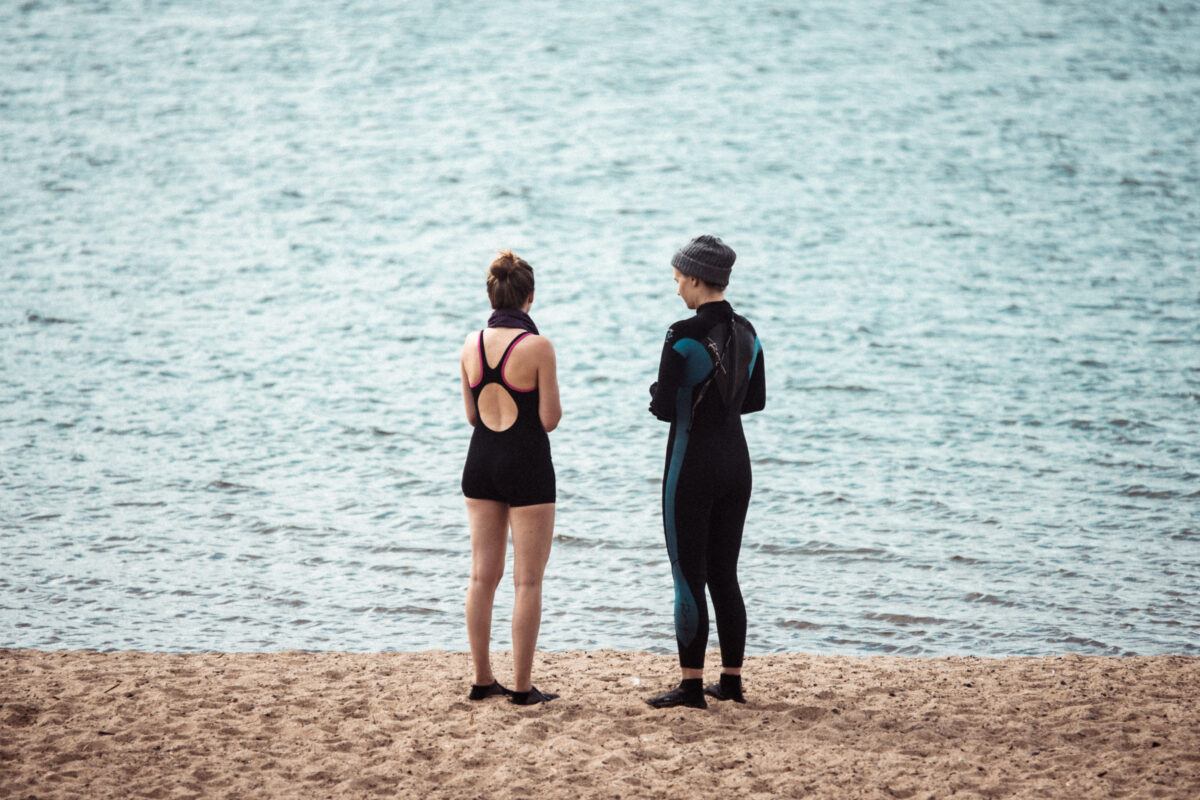Notes on Maija Mustonen’s Buoyant
Saaronniemi, Ruissalo
Saturday 3.9.22
“Imagine your weight and weightlessness, the movements of the sea on your skin under the autumn sky, you are floating.” –Maija Mustonen.
The artist and performer Maija Mustonen led the exercise Buoyant in the waters of the Archipelago Sea in Saaronniemi, Ruissalo, as part of CAA x NPT How do you know what you know? Exercises in Attentiveness II. The activity, a one-to-one facilitated floating exercise, is described by the artist and her working group (Ami Karvonen and Even Minn) as “a meeting between seawater, a giver and a recipient”.
In Buoyant, each participant was invited to be held horizontally – part-supported, part-immersed – in the Archipelago Sea for a number of minutes before returning to the shore and into a heated sauna. In the text for the exercise, the artists compare and contrast the watery capacities of the human body with that of the sea: “The salt content of human tears and sweat is close to the salinity of the Archipelago Sea. The buoyancy varies between different water bodies. Every water has its own character”.
These notes are written by Selina Oakes, a recipient and ‘buoyantee’.
~
I write these meanderings in the company of a sister-sea.
On the shore, in the breeze, skins begin to pucker in the Fall-ing air. Maija and I converse face-to-face, body-to-body, about the processes to come, bringing ourselves into non-verbal, bodily modes of communication. We turn and walk, side by side, into the sea. Cold, shock, my body trembles slightly as it attempts to attend to the needs which come with the transition from warm, dry skins to cool, wet limbs.
We wade, deeper, and reach a point where waters lap towards chest level; intermittent shivers take hold and my core grips onto its heat. I try to arrive in this place and attune to the new situation. Slowly, hands hold and hands squeeze to signal the start of the exercise, though, in reality, it is part of a long continuum of immersions. Its beginnings ripple through multiple motions and include the moments when we stepped into the sea, grounded ourselves on the beach, walked from the sauna building, sipped tea in the morning..
Maija and I recline my back and elevate my feet. My entire body shifts from verticality to horizontality and my shoulders, neck, head and hair are embraced by a thousand chattering droplets. The sensation of floating takes over and my joints begin to unfurl themselves. I trust, Maija trusts, we trust, with the uncertainty of the sea.
Bodies sway gently, and I feel the watery ripples move around and amongst my skin. My hands and feet bobble in their neoprene-wrapped states; held somewhere between airs and waters, they attempt to drift away from their bodily counterparts. My limbs and torso, too, begin to escape gravitational constraints.
The cold sinks deep and my breathing speeds up. I consciously push air, in and out, slower and slower, searching for the meditative moment that I had briefly sunken into. I realise that attending to this exercise requires an attunement to the multiple bodies – mine, Maija’s, the sea’s – at play. I seek to know the sea and yet, in searching, I recognise the need to know my body and to listen to its joys and limitations. Despite my desire to continue floating with my head and hair partially submerged, my body shakes and tells me otherwise.
I motion to Maija and she lifts my head onto her shoulder to ease the cold-sensations. Her hold shifts lightly and in place of forearms behind my neck and legs, comes arms and hands reaching along the sides of my back, hugging, in tandem with the sea. This brings my body ease, and breathing slows. I stay a little longer, in this buoyant form.
It is comfortable enough to close my eyes, though I catch glimpses of the clouds overhead: waters are within, beneath, amongst and above. Slowly my sense of smell catches up and attunes to the faint scents of salty waters drifting close to my nasal passages. Bodies suspend, time suspends: it is difficult to know how long we have been in the sea – does it matter? Might we begin to consider an alternative type of time-keeping, where the time spent with these waters is determined by the needs of the bodies in action?
I squeeze Maija’s forearm to signal my need to return to warmth and she softly turns me upright. These movements are slow and calm, not rushed. I breathe deeply, in and out, and meet Maija’s eyes before we meander back to the beach, leaving part of ourselves with the sea while bringing part of it to the shore. I sway slightly upon reaching land, reattuning myself to gravity and the feeling of the earth between my toes. We walk, gently, together. This is an exercise of exchange in which no one agent emerges unchanged.
I rejoin my fellow buoyantees in the sauna where a momentary micro-community emerges: we share our kindred experiences as, one by one, we (re)emerge from the sea. A small window in the sauna connects us visually and imaginarily to those undertaking the exercise; we stay with them as they journey down the beach, into the hands of Maija or Ami, and into those of the sea. For a brief moment, a sense of care for each participant – giver, receiver, seawater – grows between us and we are connected through the experience of having placed our trust in another.
Is this, perhaps, a type of shared, bodily knowledge that might lend itself to forging collective resiliences in the tides of climate uncertainties to come?


